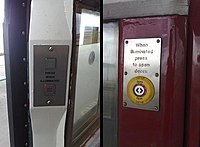
Photo from wikipedia
The energy retrofitting of existing buildings is of major importance to reach the energy sustainability target set by the European Union (EU) for 2020. Innovative retrofitting solutions can involve the… Click to show full abstract
The energy retrofitting of existing buildings is of major importance to reach the energy sustainability target set by the European Union (EU) for 2020. Innovative retrofitting solutions can involve the adoption of Phase Change Materials (PCMs), but an effective use of PCM in buildings requires an appropriate selection of the thermo-physical properties, quantity and position of the PCMs. To guarantee a good functioning of a PCM and ensure economic feasibility, an optimisation of PCM use is advisable. In the present paper, multi-objective optimisation analyses for the energy retrofitting of office buildings with PCM-enhanced opaque building envelope components are presented. A retrofitting intervention on either the external or internal side of the opaque envelope was considered, and a maximum of two PCM layers with different melting temperatures were selected and placed in different positions within the wall. Two sets of objective functions were minimised; first, primary energy consumption and global costs, and then the building energy needs for heating and cooling and investment costs. The search variables included the thickness and thermo-physical properties of the PCM layers, the window type, the insulation and internal lining materials, the wall configuration and U-value. In order to provide a robust methodology to drive designers towards an informed choice of the final retrofitting strategy, post-optimisation analyses were additionally carried out to investigate the variable values that led to the optimal solutions. Interesting and non-trivial information was obtained. The optimal thermo-physical properties of PCMs were found to be affected in particular by the operation of the HVAC system.
Journal Title: Applied Energy
Year Published: 2018
Link to full text (if available)
Share on Social Media: Sign Up to like & get
recommendations!